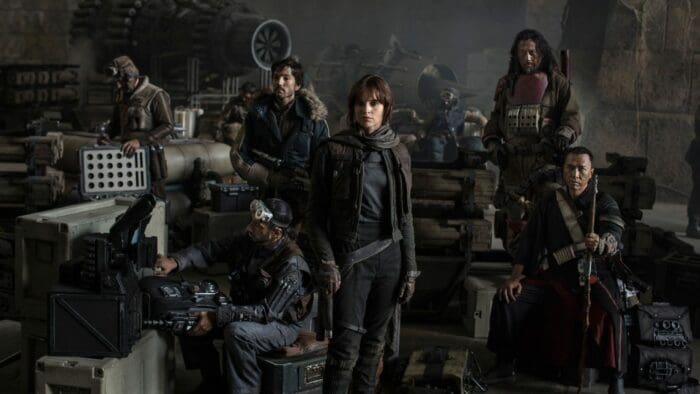The Force Awakens was the female-led Heroes Journey I’d dreamed of through a tomboy childhood. Rogue One is just flat out an amazing Star Wars movie.
Rogue One: A Star Wars Story may be the most aptly named film to come out this year. It’s a fantastically well-made, well-loved Star Wars film that manages to give us the same epic scale, overwhelming odds, and plucky upstarts as the original, while also skating casually onto the screen with a diverse cast that manages to make everyone feel a little more in the picture.
The decision to put out a series of stand alone films separate from, but complementary to, the central narrative of The Force Awakens COULD have felt like a cynical cash grab. Instead, Rogue One demonstrates how to do an effective prequel, with legitimate stakes. It also, unintentionally, makes the case for the power of non-episodic epics, really revelling in the ability to tell the full story it came to tell and nothing more.
*THERE BE SPOILERS AHEAD*
The plot begins with Galen Erso and his family – in hiding to avoid having to design a “super weapon”- at the moment when Galen is captured by the Empire, his wife killed, and his daughter escaping into exile with a mad-man version of Forest Whitaker. That daughter, Jyn Erso, grows up with a healthy dose of fear of all organizations (rebel or imperial) despite impressive training as a would-be rebel. The main action picks up when the Death Star (of Alderaan-destroying fame) has been completed, and the slipshod Rebel alliance tries desperately to stop it coming online. Jyn, now a prickly twenty-something getting arrested across the universe, is picked up by Cassian Andor (Diego Luna) and brought, kicking and glowering, into the world of the Rebel Alliance. They pick up a merry band of misfits, watch the Death Star destroy a whole city, and eventually work together to find and transmit the architectural plans for the Death Star, where Jyn’s father has had his ultimate revenge – designing a tiny flaw so significant that it can destroy the whole thing with a single well placed blaster (use the force, Luke).
The movie ends (MAJOR SPOILERS) in the five minutes leading up to Episode 4, with a piece of uncanny CGI that boggles the mind. But despite the fact that the end destination for those plans was ALWAYS going to be in Leia’s hands, Rogue One never suffers from prequelitis – the sense that all is ordained and therefore stakeless. It does an excellent job of weaving in moments for fans to cheer at (another wonderful piece of CGI allows Guy Henry to play Grand Moff Tarkin, from Episode 4, and look EXACTLY like Peter Cushing) while also providing a completely separate story with real stakes for the new characters that we have met.
The decision to make Rogue One stand completely alone, truly ending the story before the credits roll, gives the movie a finality that so few are afforded in a world where Now You See Me has become a franchise. Because Rogue One is both a part of an existing continuity, and its own discrete unit, it gets to have its epic cake and eat it too.
There were some problems with the film too. The pacing, especially in the first hour, is a little off and I thought the movie was ending at least twice before it actually did (and, had it ended there, this review would likely have been a lot less positive). There still remains a bit a of a sexism problem in the Star Wars universe that no number of female protagonists can really fully conquer- the movie squeaks past the Bechdel Test, which is almost impressive given how fully it invests in its protagonist. And the appearances by Darth Vader, while mostly awesome, also feature one of the most cringe-worthy Dad jokes I’ve ever seen uttered by a cyborg with the power to choke the life out of his enemies. I can only assume it was a really subtle reference to the fact that Vader IS a Dad at this point in his life, though he doesn’t know it yet.
But all of that goes away when a movie is as FUN as Rogue One, just a well-crafted and imaginative romp through the galaxy. It out-Lucases Lucas, managing to do everything that the prequels failed at, while also making a convincing argument for the existence of all future stand-alone films in the Star Wars extended universe.
** There’s also, if you’re the type to look for them, some heartbreaking parallels to be drawn here, whether it’s the war-ravaged city being casually destroyed by heartless leaders, or the strong appeal of fascism in a world that feels confusing and dangerous.

